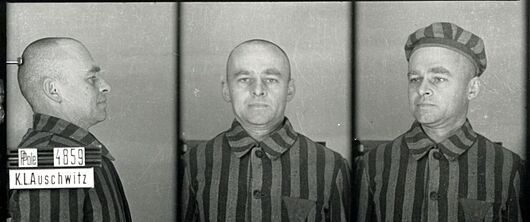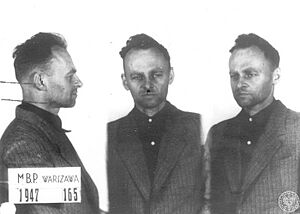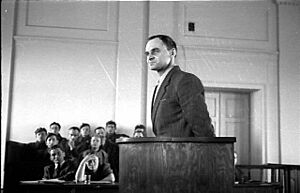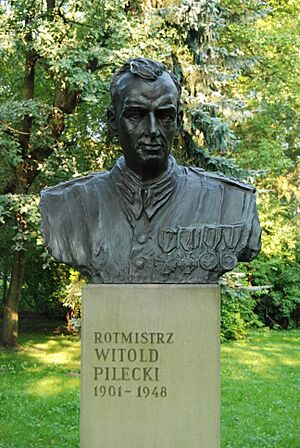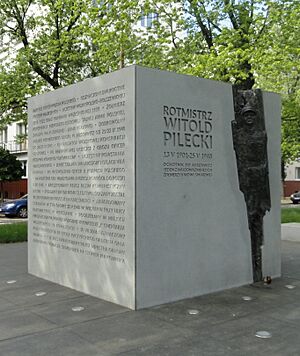Witold Pilecki facts for kids
Quick facts for kids
Witold Pilecki
|
|
|---|---|
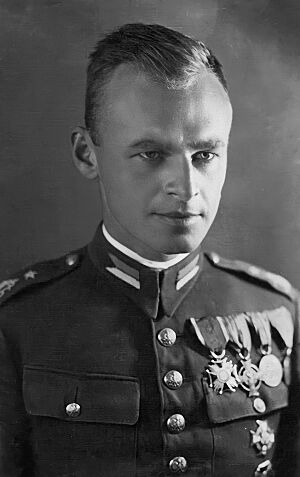
Pilecki in a pre-1939 photograph
|
|
| Born | 13 May 1901 Olonets, Olonetsky Uyezd, Olonets Governorate, Russian Empire |
| Died | 25 May 1948 (aged 47) Mokotów Prison, Warsaw, Polish People's Republic |
| Cause of death | Execution by shooting |
| Buried |
Unknown; possibly in Powązki Military Cemetery
|
| Allegiance | |
| Years of service | 1918–1947 |
| Rank | Cavalry captain (rotmistrz) |
| Commands held |
|
| Battles/wars |
|
| Awards |
|
| Alma mater |
|
| Spouse(s) |
Maria Ostrowska
(m. 1931) |
| Children | 2 |
Witold Pilecki (born May 13, 1901 – died May 25, 1948) was a brave Polish soldier and World War II hero. He was a cavalry officer, a spy, and a leader in the resistance against the German occupation during World War II.
Pilecki joined Polish scouting groups when he was young. After World War I, he became part of the Polish Army. He fought in the Polish–Soviet War which ended in 1921. In 1939, he helped defend Poland against the German invasion. Soon after, he joined the Polish resistance. He even helped start a group called the Secret Polish Army.
In 1940, Pilecki did something incredibly brave. He volunteered to be captured by the Germans. His goal was to sneak into the Auschwitz concentration camp. He wanted to find out what was happening there. At Auschwitz, he created a secret resistance group. This group grew to include hundreds of prisoners. He secretly wrote reports about the terrible things happening in the camp. These reports were smuggled out to the Home Army and shared with the Western Allies.
Pilecki managed to escape from Auschwitz in April 1943. He then fought in the Warsaw Uprising in 1944. After the uprising was defeated, he was held in a German prisoner-of-war camp. After the war, Poland came under communist rule. Pilecki remained loyal to the Polish government that was in exile in London. In 1945, he returned to Poland to report on the situation. He wrote down all his experiences from Auschwitz in a document called Witold's Report. He knew he might be in danger from the new communist government. In 1947, the secret police arrested him. He was accused of working against the state. After being tortured and put through a unfair trial, he was executed in 1948.
For many years, his story was not widely known in Poland because of the communist government. But after communism ended, historians were able to research his life. Now, Witold Pilecki is recognized as a great hero.
Contents
Witold Pilecki's Early Life
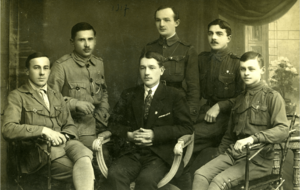
Witold Pilecki was born on May 13, 1901. His birthplace was the town of Olonets in the Russian Empire. His family was Polish nobility. His ancestors had been sent to Russia from their home in Lithuania. This happened because they took part in an uprising in 1863–64.
In 1910, Witold moved to Vilnius with his mother and siblings. He went to a Polish school there. He also joined a secret scouting group called the Polish Scouting and Guiding Association.
During World War I, in 1916, Pilecki was sent to a school in Oryol, Russia. This city was safer from the war. There, he started a local chapter of the scouting group.
Fighting for Poland's Freedom
Polish–Soviet War Experience
In 1918, after the Russian Revolution and the end of World War I, Pilecki returned to Vilnius. He joined a local defense group. This group disarmed German soldiers and prepared to defend Vilnius from the Soviet Red Army. When Vilnius fell to Soviet forces in January 1919, Pilecki and his unit fought as guerrillas behind enemy lines.
He then went to Białystok and joined the new Polish Army. He fought in the Polish–Soviet War from 1919 to 1920. He was part of battles like the Vilna offensive and the defense of Grodno. On August 5, 1920, Pilecki joined a cavalry unit. He fought in the very important Battle of Warsaw. This battle saved Poland from Soviet invasion.
Between the Wars
After the Polish-Soviet War ended in March 1921, Pilecki was promoted to corporal. He then joined the army reserves. He took courses to become a non-commissioned officer. He also finished his high school education.
In 1926, Pilecki became the owner of his family's land, Sukurcze. In 1931, he married Maria Ostrowska. They had two children, Andrzej and Zofia. Pilecki was active in his local community. He also enjoyed writing poetry and painting. He organized a military horsemen training program. In 1938, he received the Silver Cross of Merit for his work.
World War II: A Hero's Journey
Defending Poland in 1939
As tensions grew between Poland and Germany in 1939, Pilecki was called to serve in the army. He was a cavalry platoon commander. His unit fought bravely against the German invasion of Poland. His division was almost destroyed in battle. Its remaining soldiers joined another division. Pilecki and his men destroyed seven German tanks and shot down one aircraft.
On September 17, the Soviet Union also invaded eastern Poland. This made the situation even worse for the Polish forces. Pilecki and many other soldiers chose not to retreat. Instead, they decided to stay in Poland and fight underground.
Joining the Resistance Movement
On November 9, 1939, in Warsaw, Pilecki and others founded the Secret Polish Army. This was one of the first underground groups in Poland. Pilecki became its organizational head. The group grew to cover Warsaw and other major cities. Pilecki worked as a cosmetics store manager as a cover for his secret activities.
The Secret Polish Army was based on Christian values. However, Pilecki noticed that the leader, Jan Włodarkiewicz, was becoming more anti-semitic and extreme. Włodarkiewicz wanted Poland to be a purely Christian nation. Pilecki disagreed with these views. He went to Colonel Stefan Rowecki, who led a rival group called the Union of Armed Struggle. This group believed in equal rights for Jewish people.
Pilecki wanted his group to join Rowecki's organization. Włodarkiewicz refused at first. But in August, Włodarkiewicz announced that they would join the mainstream resistance. He also suggested that Pilecki should infiltrate the Auschwitz concentration camp. At that time, people did not know much about Auschwitz. They thought it was a large prison, not a death camp. Pilecki saw this as a difficult task, but he agreed to go.
Infiltrating Auschwitz
Pilecki allowed himself to be captured by the Germans on September 19, 1940. He used fake identity papers belonging to Tomasz Serafiński. He was arrested during a street roundup in Warsaw. Along with 1,705 other prisoners, Pilecki arrived at Auschwitz on September 21 or 22, 1940. He was given prisoner number 4859.
Inside Auschwitz, Pilecki secretly created a resistance group called the Military Organization Union (ZOW). Their goals were to keep up the prisoners' spirits, share news from outside, give extra food and clothing to members, and gather information. They also planned to train groups to take over the camp if a rescue attack happened. Many smaller resistance groups in Auschwitz eventually joined ZOW.
Pilecki secretly wrote reports about the camp. He sent them to the Home Army headquarters using prisoners who were released or escaped. The first report in October 1940 described the camp and how prisoners were being starved and brutally punished. Pilecki hoped the Home Army would allow ZOW to start an uprising to free the camp. But no such permission came.
In 1942, Pilecki's group even built a secret radio transmitter. They used smuggled parts to build it over seven months. They broadcast details about the number of arrivals and deaths in the camp. This information was very important for the Western Allies. Pilecki hoped the Allies would send weapons or troops, or that the Home Army would attack the camp from outside.
The camp's secret police tried hard to find ZOW members. Many were killed. Pilecki decided to escape to convince Home Army leaders that a rescue attempt was possible. On the night of April 26–27, 1943, Pilecki and two friends were working at a bakery outside the camp fence. They forced open a metal door, overpowered a guard, and cut the telephone line. They escaped and headed east. They reached a safe house owned by Tomasz Serafiński, the person whose identity Pilecki had used. During his escape, German soldiers shot at him, and he was wounded but not seriously.
After Escaping Auschwitz
After his escape, Pilecki contacted the Home Army. In June 1943, he wrote a detailed report about Auschwitz. In August 1943, back in Warsaw, Pilecki wrote Witold's Report. This report focused on the underground resistance in Auschwitz. He wanted to persuade the Home Army to free the prisoners. However, the Home Army decided such an attack would fail. They believed they did not have enough transport or supplies for the rescued prisoners. The Soviet Red Army, though close to the camp, did not want to work with the Home Army.
Pilecki then joined a sabotage unit called Kedyw. He also joined a secret anti-communist group. In February 1944, he was promoted to cavalry captain. He continued to help the resistance efforts. Pilecki also helped Jewish families hiding in Warsaw by providing them with money from the Polish resistance.
Warsaw Uprising Hero
When the Warsaw Uprising began on August 1, 1944, Pilecki volunteered to fight. He started as a regular soldier. After many officers were killed, Pilecki revealed his true rank. He took command of a company in downtown Warsaw. After the uprising was defeated on October 2, he was captured by the Germans. He was sent to a prisoner-of-war camp in Bavaria until he was freed on April 29, 1945.
Life After the War
In July 1945, Pilecki joined the Polish military intelligence in Italy. In October 1945, he was ordered to return to Poland. His mission was to report on the situation under Soviet occupation. By December 1945, he was in Warsaw and began setting up a spy network. He recruited former members of his resistance groups.
To stay hidden, Pilecki used different names and changed jobs often. He worked as a jewelry salesman and a construction warehouse manager. But in July 1946, he learned that the secret police knew who he was. His superiors told him to leave Poland, but Pilecki did not want to because his wife and children were there. In early 1947, the order was cancelled.
On May 8, 1947, the communist authorities arrested Pilecki. He was tortured, but he did not reveal any important information to protect others. He was put on an unfair trial on March 3, 1948. He was accused of crossing the border illegally, using fake documents, carrying illegal weapons, and spying for "foreign imperialism" (the Polish government-in-exile). He denied planning to assassinate officials. He admitted passing information to the Polish II Corps, as he considered himself an officer of that group. He pleaded guilty to the other charges.
On May 15, he was sentenced to death along with three of his friends. Many Auschwitz survivors asked for him to be pardoned, but their pleas were ignored. On May 25, 1948, Pilecki was executed by a shot to the back of the head at the Mokotów Prison in Warsaw. His burial place has never been found.
Pilecki's Legacy
Witold Pilecki's life has been written about in many books. One of the first in English was Fighting Auschwitz: The Resistance Movement in the Concentration Camp (1975). In 2012, Pilecki's Auschwitz diary was translated into English as The Auschwitz Volunteer: Beyond Bravery. Poland's Chief Rabbi, Michael Schudrich, wrote that "When God created the human being, God had in mind that we should all be like Captain Witold Pilecki." Historian Norman Davies called him "an Allied hero who deserved to be remembered and celebrated."
After the fall of communism in Poland in the 1990s, Pilecki was officially recognized as a hero. Many institutions, monuments, and streets in Poland are now named after him. In 1995, he received the Order of Polonia Restituta. In 2006, he received Poland's highest award, the Order of the White Eagle. On September 6, 2013, he was promoted to colonel. In 2012, parts of Powązki Cemetery were dug up to try and find his remains, but they were not found.
In 2016, The Pilecki Family House Museum was created in Ostrów Mazowiecka. It officially opened in 2019. The Pilecki Institute was founded in 2017. It is a Polish government institution that honors people who helped Polish victims of war crimes.
There have been films about Pilecki, such as Śmierć rotmistrza Pileckiego (2006) and Pilecki (2015). These films show him as a very ethical and brave man who stayed true to his country. In 2014, the Swedish band Sabaton released a song about him called "Inmate 4859."
See also
 In Spanish: Witold Pilecki para niños
In Spanish: Witold Pilecki para niños


